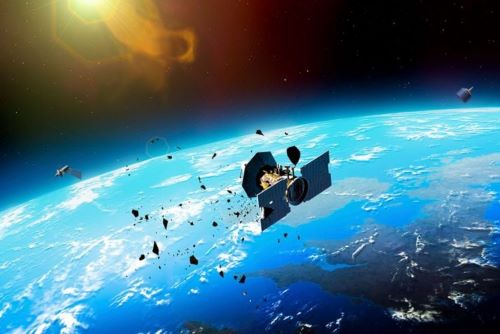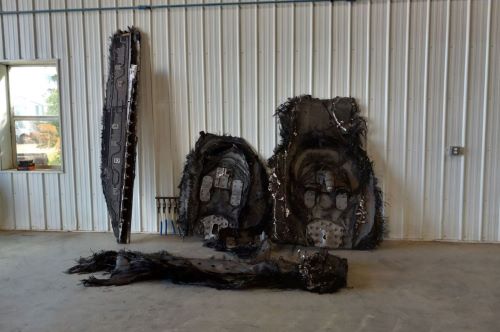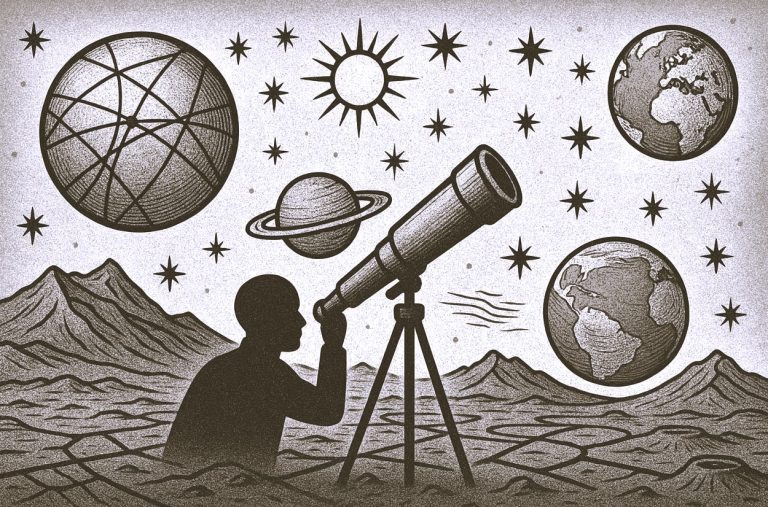

Debris from rockets and satellites can fall back to Earth or collide with other objects.

By Dan Falk
Journalist, Author, Broadcaster
When astronomer Samantha Lawler got an email from a journalist in May 2024 saying that space junk may have landed in a farmer’s field an hour’s drive from her home in Regina, Saskatchewan, she was skeptical. “I thought, ‘Yeah, right.’ A farmer right near me found space junk—what are the odds?”
But it was true: Several pieces of a SpaceX Dragon trunk (the portion of the rocket just below the capsule) had landed on the property and on nearby farms. “The longest piece was probably eight feet long, and it weighed 80 pounds,” says Lawler, who teaches at the University of Regina. “If that hit your house, it would go right through; it wouldn’t even slow down.”
Lawler returned to the farm several weeks later, when two SpaceX employees arrived in a small truck to cart away the debris. “They silently picked up the pieces and loaded them into the U-Haul,” she says. For Lawler, the incident drove home the growing problem of space junk—and left her with a sense of dread that’s never quite gone away. “Actually standing next to the pieces and thinking about them falling at terminal velocity [about 165 feet per second]—that is terrifying.”
The increasing frequency of rocket launches is crowding the region of space closest to Earth, known as low-Earth orbit—a zone that’s already peppered with tens of thousands of bits of decades-old hardware, some of it dating back to the Cold War. Experts caution that the danger posed by all this space junk is rising sharply. Incidents like the one in Saskatchewan “are going to become much more common,” says Lawler. Eventually, she says, “someone will die from this.”
In recent years, debris has fallen on Australia, Indonesia, India, Ivory Coast, Uganda, Kenya, Poland and several U.S. states. Aside from falling to Earth, objects may also smash into each other in orbit—as happened in 2009 when two communications satellites, one of them defunct, collided some 500 miles above Siberia; such collisions create even more debris. The International Space Station, meanwhile, was forced to dodge space junk twice in one week in 2023, and again last November.
Scientists also point to the potential danger to commercial aviation, as well as the pollution caused by debris burning up in the atmosphere. A report released by the European Space Agency in April noted that about 1,200 objects re-entered the Earth’s atmosphere in 2024. Experts estimate that at least 120 of these re-entries were uncontrolled, meaning they struck the Earth at some random spot beneath their orbital path. The agency said that more than 50,000 objects larger than ten centimeters (about four inches) across are currently in orbit, along with about 9,300 still-active satellites.
“We’re seeing a step-change in the amount of human activity in space,” says Jonathan McDowell, an astrophysicist at the Center for Astrophysics, Harvard & Smithsonian, in Cambridge, Massachusetts, who has been tracking objects in space for the past four decades.
Much of this activity comes in the form of satellites designed to carry broadband internet to users around the world. SpaceX has been a leading player in this effort through its “constellations” of Starlink satellites. “Since 2019, with the first Starlink launch, we’ve gone from 1,000 working satellites to over 11,000 working satellites,” says McDowell. Amazon, meanwhile, is poised to compete with Starlink with its Kuiper satellite system; the first of these was launched in April. And China had the first launch of its planned 13,000-satellite Guowang system last December.

With so much hardware currently in orbit, it’s hardly a surprise that bits and pieces sometimes come down. And when they do, they pass through another congested region: commercial airspace. A study published in January in Scientific Reports suggests there’s more than a one-in-four chance that rocket debris will fall through a busy commercial flight area in any given year. While no resulting collision has yet occurred, in 2022 airspace above France and Spain was closed while a 20-ton piece of a Chinese rocket re-entered the atmosphere.
“In even moderately busy airspace, there’s a high probability of getting disrupted by re-entering space junk,” says Aaron Boley, an astronomer at the University of British Columbia who wrote the study with colleagues Ewan Wright and Michael Byers.
Byers describes a potential scenario in which a discarded rocket body is found to be on a trajectory that would take it over the greater New York City area: “If air traffic control authorities in the United States decided to do a precautionary airspace closure, the costs to airlines, to passengers and to the U.S. economy would be significant.”
“Anyone’s individual risk is extremely small,” he adds, “but the collective risk that somebody is going to get hurt is now rising to a few percent per year.”
And Earth’s atmosphere is also affected. Because rockets are primarily composed of aluminum, when they burn up they release aluminum oxide, which can contribute to the depletion of the ozone layer. Most rockets also burn fossil fuels, causing pollution during the launch phase.
For the satellite companies, having their hardware burn up in the atmosphere is seen as the lesser of two evils; it’s better than having debris hit the ground. On Starlink’s website, a document titled “Commitment to Space Sustainability” briefly details the company’s efforts to minimize the risk posed by their satellites by deorbiting them in a controlled manner so that they come down far from populated areas. The document says that their satellites “are also fully demisable by design, meaning that the risk to those on the ground, in the air, or at sea from a deorbiting satellite is effectively zero as the satellites burn up during re-entry.” (SpaceX did not reply to requests for an interview.)
But McDowell says that all that incineration is a problem in its own right. “We’re now seeing the retirement of the first generation of Starlink satellites, with several re-entering per day at this point, and over 1,000 down so far,” he says. “That’s an unprecedented input of using the upper atmosphere as an incinerator and adding material to the upper atmosphere.”
Lawler, too, believes this issue isn’t being taken seriously enough—something she noticed at a United Nations-sponsored workshop on space technology that she attended last year in Italy. “It was basically just me and a bunch of satellite builders and operators,” she says. “And they absolutely had this mentality of, ‘You just burn it up in the atmosphere and it’s gone. It’s fine, right?’ That’s really how they think about it.”
While space is not entirely unregulated, scientists say that the laws governing its use are becoming antiquated. The United Nations Committee on the Peaceful Uses of Outer Space, geared toward fostering international cooperation in space, has been meeting annually since 1959. The committee oversaw the drafting of the Outer Space Treaty; dating from 1967, it is seen as a cornerstone of space law. The treaty is fine as far as it goes, says Byers, but he points out that it’s focused on liability: For example, it stipulates that if a rocket launched by Country A injures or kills someone in Country B, or causes damage to Country B, then Country A is legally and financially responsible. Space launches are also regulated by the governments of individual nations. For instance, in the U.S., the Federal Aviation Administration Office of Commercial Space Transportation regulates commercial space launches, and the Federal Communications Commission licenses individual satellites.
“The regulations and norms we have at the moment were fine for 20 years ago, but they’re not really strong enough for the level of activity we have in space now,” says McDowell. “I think there’s generally a feeling that we need to have tighter regulations, but there’s not a lot of motion toward making it happen.”
Although many debris objects continue to fall haphazardly, the technology for controlled re-entry exists—so Byers believes that governments and companies should make it a priority. “There’s a role here for national governments to perhaps require controlled re-entries or, at a minimum, to only contract for launches that include controlled re-entries.”
Meanwhile, some space junk is orbiting at a high enough altitude that it won’t burn up—meaning such objects simply remain in orbit, posing an ongoing danger to other spacecraft and satellites at the same altitude. “In lower orbits, below 600 kilometers [370 miles], the natural cleaning effect of the Earth’s atmosphere is enough to eventually clean that stuff out,” says McDowell. “But between 600 kilometers and 2,000 kilometers [1,200 miles], in the upper part of low-Earth orbit, that’s not going to happen. The atmosphere is never thick enough. And so really we have to go and get rid of this junk that’s up there.”
Various strategies have been put forward for cleaning up low-Earth orbit. A Japanese company called Astroscale recently debuted a prototype for a kind of “space garbage truck” that it hopes can retrieve defunct satellites from orbit. ClearSpace, a Swiss company working in conjunction with the European Space Agency, is planning similar retrieval missions. Another solution, in the short term at least, is to boost objects to higher orbits, where they pose less of a danger. In 2022, a Chinese mission boosted a defunct BeiDou navigation satellite into a higher and less crowded zone.
A longer-term solution would involve recycling such objects—and some of that recycling can happen in orbit, McDowell says. “At some point we’re going to have to move from disposing of old satellites in the atmosphere to taking them to recycling stations where their parts get reused for new satellites, and we actually do some of the manufacturing in orbit.” Moriba Jah, a space scientist and aerospace engineer at the University of Texas at Austin, calls this the “circular space economy,” and the European Space Agency suggests it can be achieved by 2050.
Another seemingly simple idea is to make satellites more durable.
“The message that I keep trying to deliver to anybody who will listen is: We need to have fewer satellites with longer operational lifetimes,” says Lawler. “Anything that you can do to make your satellites last longer and to use fewer of them—that is the engineering challenge that we are now facing, and I don’t see anyone really taking that up.”
Originally published by Smithsonian Magazine, 07.03.2025, reprinted with permission under a Creative Commons license for educational, non-commercial purposes.


